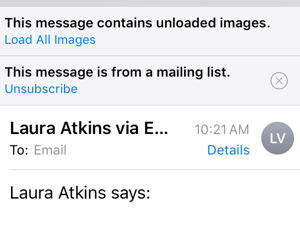Delivra has a new whitepaper written by Ken Magill talking about the value (or lack thereof) of relationships with ISPs. In Ken’s understated way, he calls baloney on ESPs that claim they have great delivery because they have good relationships with ISPs.
He’s right.
I get a lot of calls from potential clients and some calls from current clients asking me if I can contact an ISP on their behalf and “tell the ISP we’re really not a spammer”. My normal answer is that I can, but that there isn’t a place in the spam filtering process for “sender has hired Laura and she says they’re not a spammer.” I mean, it would be totally awesome if that was the case. But it’s not. It’s even the case where I’m close friends with folks inside the ISPs.
I’m pretty sure I’ve told the story before about being at a party with one of the Hotmail ISP folks. There was a sender that had hired me to deal with some Hotmail issues and I’d been working with Barry H. (name changed, and he’s not at Hotmail any more) to resolve it. During the course of the party, we started talking shop. Barry told me that he was sure that my client was sending opt-in mail, but that his users were not reacting well for it. He also told me there was no way he could override the filters because there wasn’t really a place for him to interfere in the filtering.
Even when folks inside the ISPs were willing and able to help me, they usually wouldn’t do so just because I asked. They might look at a sender on my request, but they wouldn’t adjust filters unless the sender met their standards.
These days? ISPs are cutting their non-income producing departments to the bone, and “sender services” is high up the list of departments to cut. Most of the folks I know have moved on from the ISP to the ESP side. Ken mentions one ISP rep that is now working for a sender. I actually know of 3, and those are just employees from the top few ISPs who are now at fairly major ESPs. I’m sure there are a lot more than that.
The reality is, you can have the best relationships in the world with ISPs, but that won’t get bad mail into the inbox. Filters don’t work that way anymore. That doesn’t mean relationships are useless, though. Having relationships at ISPs can get information that can shorten the process of fixing the issue. If an ISP says “you are blocked because you’re hitting spam traps” then we do data hygiene. If the ISP says “you’re sending mail linking to a blocked website” then we stop linking to that website.
I have a very minor quibble with one thing Ken said, though. He says “no one has a relationship with Spamhaus volunteer, they’re all anonymous.” This isn’t exactly true. Spamhaus volunteers do reveal themselves. Some of them go around openly at MAAWG with nametags and affiliations. A couple of them are colleagues from my early MAPS days. Other do keep their identities secret, but will reveal them to people they trust to keep those identities secret. Or who they think have already figured it out. There was one drunken evening at MAAWG where the nice gentleman I was joking with leaned over and says “You know I am elided from Spamhaus, right?” Uh. No? I didn’t. I do now!
But even though I have the semi-mythical personal relationship with folks from Spamhaus, it doesn’t mean my clients get preferential treatment. My clients get good advice, because I know what Spamhaus is looking for and can translate their requirements into solid action steps for the client to perform. But I can think of half a dozen ESP delivery folks that have the same sorts of relationships with Spamhaus volunteers.
Overall, relationships are valuable, but they are not sufficient to fix inbox delivery problems.
Read More
